door Kristofer G. Skaug
19/02/2017
English version below! Follow this link.
Docentenconcert
We zijn weer aangeschoven voor een matineeconcert op de late zondagochtend (12 uur) in de Sweelinckzaal, na een behoorlijk laat en nat feestje in Splendor gisteren.
Eerst spelen Marjolein Dispa, Francien Schatborn, Richard Wolfe en Jürgen Kussmaul samen het 3e concert voor 4 altviolen van Telemann. Vooral het rustige derde deel “Largo e staccato” spreekt mij aan. Er wordt ook met barokstokken gespeeld, dat komt in dit stuk de klankkleur en de luchtigheid van de noten ten goede.
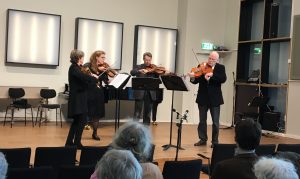 Maar het hoofdgerecht wat mij betreft komt met het strijkkwintet van Mozart in g kl.t. (KV516). Het mooiste van allemaal, en daarom gespaard als kers op de taart van het “Mozart-kwintet-marathon” van gisteren. Het altenkwintet bestaat uit Richard Wolfe en Marjolein Dispa op altviool, terzijde gestaan door Peter Brunt, Emma Rooijakkers (viool) en Michel Dispa (cello). Het eerste deel heeft een onvergetelijk melodieus hoofdthema met een vleugje chromatiek, als een kat die kopjes komt geven. Daar ben ik altijd wel voor in. Het ensemble produceert een zeer aangename fluwelen samenklank.
Maar het hoofdgerecht wat mij betreft komt met het strijkkwintet van Mozart in g kl.t. (KV516). Het mooiste van allemaal, en daarom gespaard als kers op de taart van het “Mozart-kwintet-marathon” van gisteren. Het altenkwintet bestaat uit Richard Wolfe en Marjolein Dispa op altviool, terzijde gestaan door Peter Brunt, Emma Rooijakkers (viool) en Michel Dispa (cello). Het eerste deel heeft een onvergetelijk melodieus hoofdthema met een vleugje chromatiek, als een kat die kopjes komt geven. Daar ben ik altijd wel voor in. Het ensemble produceert een zeer aangename fluwelen samenklank.
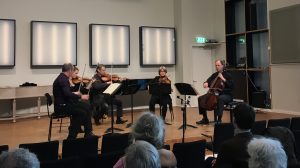 In het menuet hebben de twee alten een bepalende middenstemvoering, maar is het ietswat verrassend de tweede violist(e) die het laatste woord krijgt. Het middendeel (adagio, non troppo – con sordino) wisselt dialoog en samenklank elkaar af. De 2e alt is de “vrije man” (excuus, vrouw) en wordt speels ingezet om de 1e viool van repliek te dienen, en soms om de baslijn van de cello over te nemen. Muziek om bij weg te dromen. Ietswat ongebruikelijk komt er een tweede Adagio-deel er achteraan. Nu in een rustige drie-tel en zonder sordine. Maar het is eigenlijk niet mer dan een korte brug naar het snelle en vrolijke slotdeel in wals-tempo. Een mooi verzorgde uitvoering!
In het menuet hebben de twee alten een bepalende middenstemvoering, maar is het ietswat verrassend de tweede violist(e) die het laatste woord krijgt. Het middendeel (adagio, non troppo – con sordino) wisselt dialoog en samenklank elkaar af. De 2e alt is de “vrije man” (excuus, vrouw) en wordt speels ingezet om de 1e viool van repliek te dienen, en soms om de baslijn van de cello over te nemen. Muziek om bij weg te dromen. Ietswat ongebruikelijk komt er een tweede Adagio-deel er achteraan. Nu in een rustige drie-tel en zonder sordine. Maar het is eigenlijk niet mer dan een korte brug naar het snelle en vrolijke slotdeel in wals-tempo. Een mooi verzorgde uitvoering!
De Finale
Om 14:00u is de Haitinkzaal zeer goed gevuld voor het laatste hoofdstuk van het Nationaal Altvioolconcours 2017. Tastbare opwinding alom.
Martin Moriarty. Daar sta je dan, met de solo opening van Hindemith’s Schwanendreher. De hele (nederlandse) altvioolwereld kijkt toe. De door altvioolstudenten eindeloos gestudeerde reeks dubbelgrepen, die tegelijk ook een melodisch geheel moet worden. Kom je tot je schrik achter dat de eerste E-octaaf al niet klopt. Blijven lachen, vooruit denken. Ik ontkom niet aan het idee dat die eerste schrik zijn weerslag heeft op de rest van zijn uitvoering, met één hand op de noodrem.
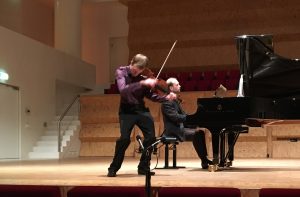 Hierna Enescu. Deze uitvoering vind ik een stuk beter dan wat Martin in de eerste ronde liet horen, meer lyrisch en minder ruw. De mooiere akoestiek in deze zaal helpt mee, maar onthult ook genadeloos elk klein misstapje. Daniël Kramer volgt hem goed in een paar spontane rubato’s, en helpt hem ook over de eindstreep met een stevig pianistisch schouderklopje. Opgeteld zijn er wel net iets teveel kleine fouten. Het is maar afwachten hoe de andere kandidaten het doen.
Hierna Enescu. Deze uitvoering vind ik een stuk beter dan wat Martin in de eerste ronde liet horen, meer lyrisch en minder ruw. De mooiere akoestiek in deze zaal helpt mee, maar onthult ook genadeloos elk klein misstapje. Daniël Kramer volgt hem goed in een paar spontane rubato’s, en helpt hem ook over de eindstreep met een stevig pianistisch schouderklopje. Opgeteld zijn er wel net iets teveel kleine fouten. Het is maar afwachten hoe de andere kandidaten het doen.
Dan is de beurt aan Billy Murray, met Martijn Willers als begeleider. Opvallend informeel gekleed, een houvast in het vertrouwde. Maar ook hij is merkbaar bevangen door de druk. Hij begin met Enescu, de zenuwen uiten zich in voorzichtige tempi en een bibberstok die 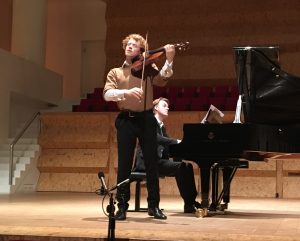 gevaarlijk op de loer ligt. Dat is de keerzijde van een gevoelsmens dat makkelijk speelplezier vindt en uitstraalt, ook zijn pijn en angst kan hij moeilijk onderdrukken.
gevaarlijk op de loer ligt. Dat is de keerzijde van een gevoelsmens dat makkelijk speelplezier vindt en uitstraalt, ook zijn pijn en angst kan hij moeilijk onderdrukken.
Na deze beproeving speelt hij het 1e deel uit het concert van Walton. Hier ligt een kansje, want hij is vandaag de enige met dit concert op het programma. Het zangerige eerste thema is een dankbare binnenkomer. De belangrijkste te nemen hindernissen liggen later op de loer. Hij bereikt nu zijn comfort zone, waar alleen de mooie diepe klank van zijn altviool ertoe doet. Danig getroost stort hij zich in een versnelde passage. Wanneer het weer tot rust komt heeft hij al met al een mooie lyrische uitvoering achter de rug.
Take Konoye komt op met pianiste Noriko Yabe voor Der Schwanendreher: Ook hij komt niet helemaal zonder kleerscheuren door de introductie heen, maar hij herpakt zich heel snel, en strijkt energisch de zenuwen van zich af. Ik moet mezelf er wel aan herinneren 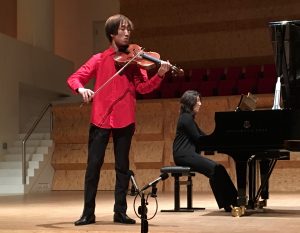 dat hier een eerstejaars student staat te spelen. In de reprise van het hoofdthema slaat hij de spijker vol op zijn kop. Bevrijdend! En hij weet het, na dat laatste C-groot slotakkoord: Het was goed.
dat hier een eerstejaars student staat te spelen. In de reprise van het hoofdthema slaat hij de spijker vol op zijn kop. Bevrijdend! En hij weet het, na dat laatste C-groot slotakkoord: Het was goed.
Het Concertstuk speelt hij samen met Martijn Willers. Take speelt nu al als een winnaar. Zijn Enescu straalt het uit – superieur paradeert hij zich erdoorheen. Doet maar rustig aan, zijn mentale voorsprong op zijn concurrenten is hier enorm. Op zijn gemak haalt hij het buit binnen. Kan niet anders, dit wordt goud.
De jury heeft het ook gezien. Take is onze nieuwe “nederlands kampioen” altviool, en krijgt tevens de publieksprijs. Billy Murray krijgt een tweede prijs en Martin Moriarty wordt derde.
Nawoord
Hartelijk dank aan het Festivalteam van het Conservatorium – met name Francien Schatborn, Richard Wolfe, Marjolein Dispa, Judith Wijzenbeek en onze ereleden Nobuko Imai en Jürgen Kussmaul, die het evenement dragen. Last but not least dank aan het productieteam Clara Brons en Marianne Berenschot en alle studenten die hebben meegeholpen.
Tot het volgende Amsterdamse festival!
~~~~~~~~~~~~~~~~~~~~~~~~~~~~~~~~~~~~~~~~~~~~
English Version
Teachers’ Lunch Concert
We are once again seated in the Sweelinckzaal for a late-morning (noon) concert, after a very “wet” and late party in Splendor yesterday.
First we are witness to a rendition of the 3rd concerto for 4 violas by Telemann. On the stage are Marjolein Dispa, Francien Schatborn, Richard Wolfe and Jürgen Kussmaul. The calm third movement “Largo e staccato” is particularly appealing to me. Baroque bows are being used, which results in a more appropriate tone colour and lightness of the notes.
But the main course (for my part) is the Mozart string quintet in G minor (KV516). This is arguably the most beautiful of them all (6), and hence it was saved for last in the Mozart quintet marathon, which was held yesterday. The viola quintet is headed up by Richard Wolfe and Marjolein Dispa on the viola, assisted by Peter Brunt, Emma Rooijakkers (violins) and Michel Dispa (cello). The first movement has an unforgettably melodious main theme with a whiff of chromatics, like a cat that rubs its head against your leg. I’m always in for that! The ensemble produces a very pleasant velvet tone.
In the menuet, the two violas have a decisive middle voice line, but it is somewhat surprisingly the second violinist who gets the last word. The central movement (adagio, non troppo – con sordino) provides an alternation of dialogue and polyphony. The 2nd viola is the “free man” (woman), being playfully employed as counterpart for the 1st violin, at other times taking over the cello bass line. This music lets you dream away. Somewhat unusual is the succession of a second Adagio-movement, this time in a calm three-quarter beat and without mutes. But this is actually just a short bridge to the quick and merry final movement. A very fine and well-worked out performance!
The Final
At 14:00h, the Haitinkzaal is filling up with audience for the final round of the National Viola Competition 2017. There is a significant buzz of excitement.
Here stands Martin Moriarty, with the solo opening of Hindemith’s Schwanendreher. The whole (Dutch) viola world is watching. Embarking on that endlessly rehearsed sequence of double stops, which also has to form a melodic line, he realizes with certain horror that the very first E-octave is out of tune. Keep smiling, think ahead! I cannot escape the impression that this first scare impacts the rest of his performance, keeping one hand on the emergency brake all the way.
Thereafter follows Enescu. I like the sound of this performance even more than Martin’s rendition in the first round, it is more lyrical, less rough in the edges. The acoustics in this auditorium help a bit, but they also mercilessly expose every small error. Daniël Kramer follows him well in a few spontaneous rubato’s, and helps him across the finish line with a firm pianistic pat on the shoulder. All in all, there are just a bit too many small errors. We have to wait and see what the other candidates will do.
Now it is Billy Murray’s turn, accompanied by Martijn Willers. His attire is conspicuously informal, a conscious footing in the familiar. But he, too, is visibly influenced by the pressure. He starts with Enescu, the nervousness results in very cautious tempi, and he visibly struggles with bow control. That is the flipside of easily tapping into and projecting your musical emotions, because also feelings of pain and fear are then difficult to suppress.
After this ordeal, he plays the 1st movement of the Walton concerto. There is an opportunity for him here, as he is the only finalist who has chosen this piece. The melodious first theme is a thankful starter. The most difficult obstacles are lurking further down the road. He now reaches his comfort zone, where only the deep sound of his viola matters, nothing else. Thus comforted, he charges into an accelerating passage. When it all returns to tranquility, he can look back on a nice lyrical performance.
Take Konoye enters the stage with pianist Noriko Yabe for Der Schwanendreher: He, too, cannot escape a few scratches in the opening section; but he recovers very quickly, energetically bowing away his nervousness. I have to remind myself that this is a first-year student playing. He totally nails the recapitulation of the main theme, a liberating sensation! And he knows, after the final C-major chord: It was good.
He plays the Concert piece with Martijn Willers with the air of a winner, parading his way through this exercise. He takes it easy, his mental advantage on the competition is at this point huge. He reels in the victory with great ease. There is no doubt left, this is Gold.
The jury has seen it, too. Take is our new “Dutch viola champion”, and receives the audience prize as well. Billy Murray gets the second prize and Martin Moriarty finishes third.
Epilogue
Our warmest thanks to the Festival team at het Conservatory of Amsterdam – in particular Francien Schatborn, Richard Wolfe, Marjolein Dispa, Judith Wijzenbeek and our honorary members Nobuko Imai and Jürgen Kussmaul, who support this event. Last but not least thanks to the production team Clara Brons and Marianne Berenschot and all helping students in Amsterdam.
See you at the next Amsterdam festival!

